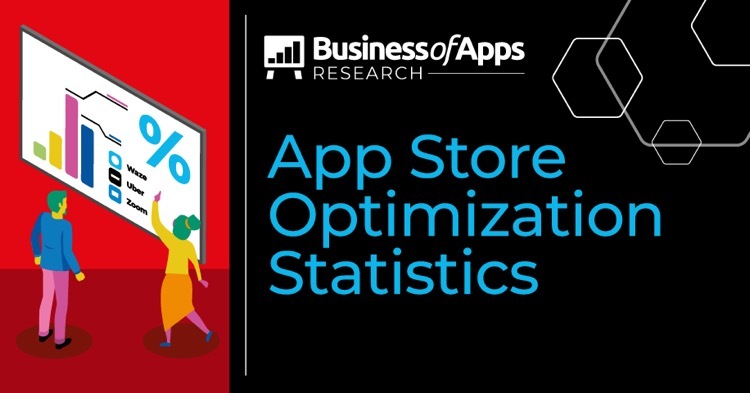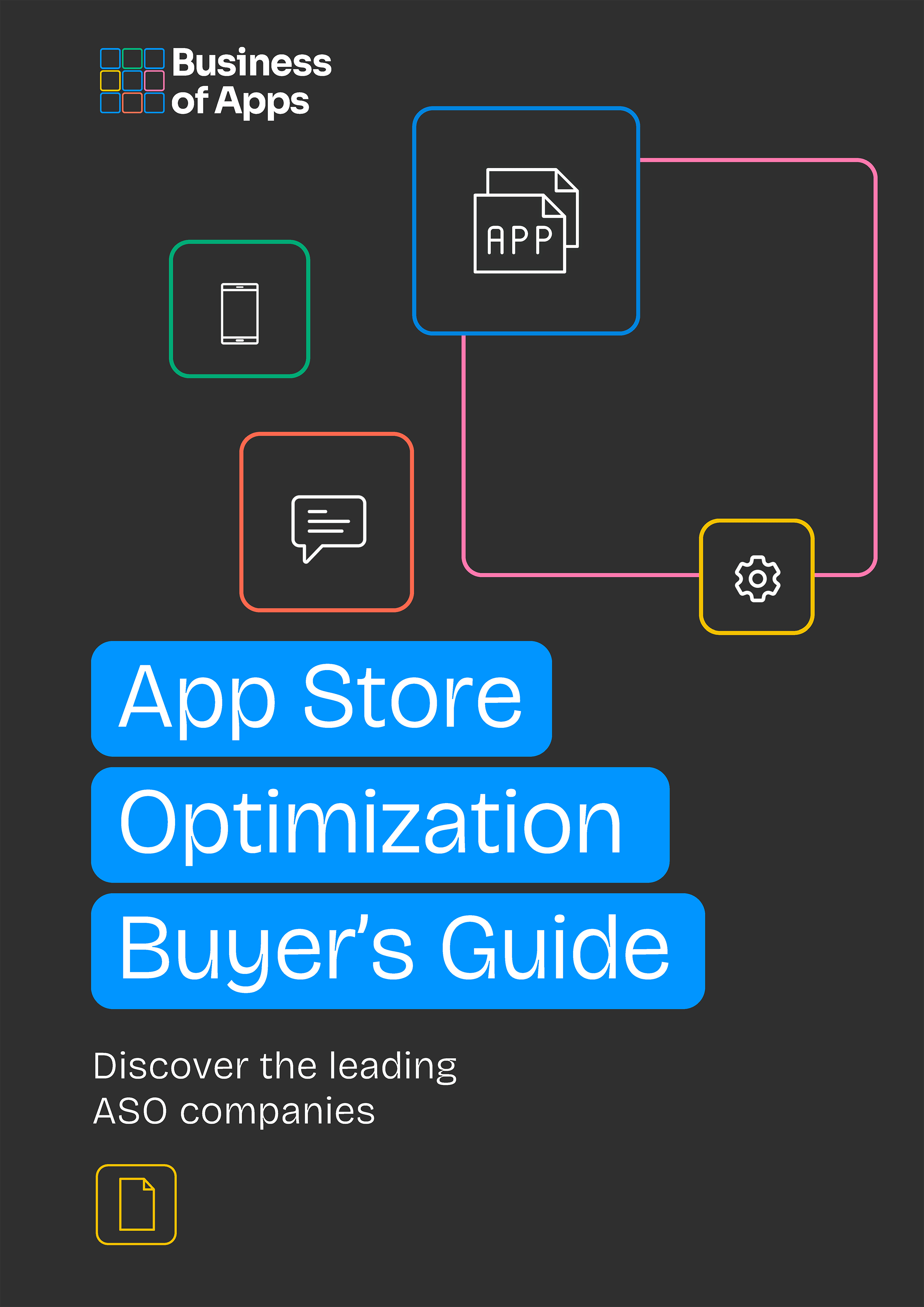
Like any other branch of digital marketing, app marketing efficiency is measured with benchmarks. This is how being an app marketer, you can stack up your app against your competitors on the market and see where you stand, see if your app is underperforming and the app marketing campaign needs a course correction.
There are several App Store and Google Play benchmarks, such as the Impression / App Page View, App Page View / Install, Impression / Instal ratio, Time On Page and Page Scroll Depth.
Featured App Store Optimization Companies
All five allow app marketers to analyze the efficiency of their app’s marketing copy to establish an app store conversion rate for the app.
Key App Store Optimization data points:
- App Store Page View to Install Conversion rate – 33.7%
- Google Play Page View to Install Conversion rate – 26.4%
- App Store Impression to Install Conversion rate – 3.6%
- App Store Average Time on Page – 10 seconds
- Google Play Average Time on Page – 14 seconds
- App Store App Page Scroll Depth – 10% for 90% of iOS app users
- Google Play App Page Scroll Depth – 10% for 80% of Android app users
First up is the Impression to App Page View rate.
Impression to App Page View rate
One of the basic but important ASO benchmarks is Impression to Page View rate. It tells you about on how many occasions mobile app impressions on the App Store or Google Play in search results or on Top Charts lead to people visiting the app’s page on these app stores.
To analyze Impression to App Page View rates, let’s take a look at recently shared data by App Store Optimization company AppTweak collected this year. It doesn’t cover the entire list of the App Store categories but provides benchmarks on a number of categories which is a good proxy for the conversion rate for the entire app store. Among the categories, the highest rate is for Travel category where 41.4% of people who saw ads for travel apps actually visited their respective pages on the app store. It’s reasonable to speculate that such high Conversion rate can be explained by people’s need to learn more about apps for traveling. Taking trips requires a lot of information and so people where compelled to click on many ads to find that single app that will give them all information they need to plan a trip.
Gummicube #1 in App Store Optimization
Elevate your app growth performance with the industry leading experts from Gummicube. Increase visibility, boost installs and reduce acquisition costs. Contact us today for a free consultation.
Contact UsThe distant second place belongs to the Reference category with only 12.7%, when people look for reference apps usually they know better what kind of app they’re looking for, apart from generic apps such Wikipedia other apps that provide reference have a narrow scope and hence either to choose. The lowest Impression to Page View rate among categories provided by AppTweak is Weather – only 6.1%. A possible reason for such low value can be relatively low demand for Weather apps in general, app users stick for the most part to the iOS native Weather app.
US iOS App Store Conversion Benchmarks, overall, by category (%)
Source: AppTweak
To get more granule picture for Impression to App Page View conversion rate, let’s analyze 2020 data collected by Storemaven, another App Store Optimization company. The data set provides information for the US App Store Conversion rate based on search, browsing and referrer. First, let’s check the numbers for the search based conversion rate. In a sharp contrast with AppTweak data, when it comes to the search specifically, the conversion rates are significantly lower.
App Store Optimization Buyer's Guide
Download our App Store Optimization Buyer’s Guide, covering all aspects of this essential app marketing technique to drive native traffic to your mobile app.
The Business category brings up the highest conversion rate – 5.9%. Perhaps even more telling difference comes from the Travel category that was directly hit by COVID-19 last year when traveling was essentially shut down completely and hence the conversion rate was only 2.9%. It means when people were trying to find new apps for traveling that perhaps could provide some options they couldn’t find any that were enticing enough to compel them to click and check out the App Store pages.
US iOS App Store Conversion Benchmarks, app store search, by category (%)
Source: Storemaven
The picture for the App Store Conversion rate based on browsing is radically different. This time the Travel category conversion rate is actually the highest among other categories in the data set – 55%. When people browse app stores, they see on the charts apps that are well know and quite popular, meaning they definitely know what these apps are about and what features they have. So chances are when people were clicking on these well known apps their intention was to see if those apps were offering any substituted for expected traveling options that the pandemic made obsolete. On the other end of the conversion rate spectrum was News category, it seems like people were avoiding checking new News apps and stuck to apps they were using before, hence the lowest value for the conversion rate – 4.2%
US iOS App Store Conversion Benchmarks, app store browse, by category (%)
Source: Storemaven
There is a third way how people can discover apps on the App Store, plus to the Search and Charts, is via the app’s Referrer traffic. An instance when an app gets Referrer traffic is when somebody clicks on a link within other apps. Obviously, this kind of the app store conversion rate should be high, because the moment when people click on links inside apps, they have enough information in front of them to be compelled to click on the link. Across the board, all app categories have a high conversion rate, with Reference being the highest – 67.5% and Weather app is the lowest – 19.6%, the latter can be attributed to people sticking to using a single app for weather checking and aren’t really into checking other apps when they use the weather app.
US iOS App Store Conversion Benchmarks, app store app referrer, by category (%)
Source: Storemaven
Next up is the App Store Conversion rate that assess an efficiency of a particular app page to compel the page visitors to install the app.
Page View to Install conversion rate
According to the AppTweak data for the entire 2020, the average Page View to Install conversion rate for the US App Store was 33.7% and 26.4% for the Google Play market. Bear in mind, this benchmark alone isn’t capable to reveal what specific factor compelled somebody to download the app. On one occasion the intention was to download the app because its description, icon and title convinced that user that this was the app she or he was looking for or the intention was to keep evaluating the app by giving it a try.
Looking at several categories analyzed by AppTweak, we see that apps from the Business category had the highest Page View to Install conversion rate – 32.7% and Food & Drink had the lowest rate – just 13.1%, that is to say – every man to his own taste.
US iOS App Store Page View / Install Benchmarks, by app category (%)
Source: AppTweak
Now, the same rate for free mobile games is more homogeneous. Action, Adventure, Arcade and Card games Page View / Install conversion rate hovers around 10-12%, with Board and Casino games being outliers – 18.6% and 7.6% respectively. Contrasting this rate for apps and mobile games, we see people being more picky when it comes to what mobile games to download, partly because mobile games have a bigger file size what may put certain limitation for mobile gamers when they are connected to the internet via mobile connection.
US iOS App Store Page View / Install Benchmarks, by game app category (%)
Source: AppTweak
Now let’s look at the next ASO benchmark, which is unique to the Apple’s App Store, specifically Impression / Install conversion rate.
Impression to Install conversion rate
Unlike with Google Play, on the App Store iOS app users can download apps not only from app pages but directly from the search results or as they browse the charts. To measure an iOS app performance on the App Store, in terms of its efficiency in this particular aspect, there is the Impression to Install conversion rate. The 2020 AppTweak ASO company data for this rate across all categories of the US App Store was 3.6% on average.
It doesn’t come as a surprise that when app users see an app either in search results or as they browse the app store charts, the number of people who are ready at that point to download apps is significantly lower, compared with when they visit app pages. It’s save to assume that people who do download apps at that point either used those apps before or know exactly what to expect.
The Finance app category has the highest Impression to Install conversion rate – 5.3%, while Education is on the other extreme with only 0.6%. Most likely in this particular case people are much more aware about what to expect from Finance apps than in the case with Education category apps.
US iOS App Store Impression / Install Benchmarks, by app category (%)
Source: AppTweak
Next up on our list of the essential App Store Optimization benchmarks is Average Time on Page, which is a mobile equivalent of a desktop average time people spend on a particular website page, expect in the app store case it’s about the period of time between opening an app’s page and downloading & installing the app presented on that page.
So let’s see how long it takes for Android and iOS app users to decide should they install the app or not.
Average Time on Page
The SplitMetrics research peers into a historical data (2018 – 2020 range) for both general Time on Page and specific figures for the App Store and Google Play categories. Let’s look at the general ones first.
Back in 2018 on average it took 13.5 seconds for both App Store and Google Play visitors to decide should they install the app they’re looking at. This number dropped to 10 seconds for both app stores in 2019 and 2020. It’s hard to say definitely what constituted into this 3.5 seconds decrease, but we can speculate that it was due to multiple reasons.
We see the same time drop for both average time for both stores and the App Store specifically. In 2018 Apple introduced Dark Mode for the App Store app along with other native apps, it improved people’s experience of using the app in low light conditions, which may helped people to decide faster should they download the app or not.
On the Google Play’s side things are a bit different. In 2018 it took 16 seconds for Android app users to decide on installing the app, this number dropped to 12.5 seconds in 2019 and then jumped back to almost 14 seconds in 2020. Android platform has much more diverse and widespread geography than iOS, in many countries of South America and Africa people can only afford less expensive smartphones that run Android OS. When in 2020 COVID-19 pandemic hit the world, it lead to widespread lockdowns and hundreds of millions people staying at home more, hence they had more time on their hands to evaluate Android apps they found on the Google Play store.
Average Time on Page for the App Store and Google Play, 2018-2020 (seconds)
Source: SplitMetrics
Let’s take a deeper look at the time it takes for the App Store visitors to make a decision on installing apps for different categories these app stores are divided into.
Across multiple categories such Music, Shopping, Lifestyle, Travel, Games and more – 14 categories in total – we see the following picture. The single app category that saw a dramatic drop from 25 seconds in 2018 to 10 in 2019 and 8 in 2020 was Photo & Video, which means that all of a sudden people were quicker in their decision to download apps to take shots and shot video. In 2019 Apple released iPhone 11 which featured sophisticated Night Mode to take high quality pictures in low light conditions, most likely that was the reason people we were more kin to try various apps from this category.
Health & Fitness was another app category that saw a dramatic increase in popularity when people stuck at home during COVID-19 lockdowns. In 2019 app users spent 14 seconds looking at the apps for keeping them in shape before hitting the Get button and in 2020 it took them only 10 seconds to download an app after reading information about it on its page.
On the flip side, in 2019 apps from the Business category took people on average 10 seconds to make up their mind, but in 2020 that time increased to 13 seconds. Of course COVID-19 forced businesses around the globe to switch from a regular office environment to working remotely, apps like Zoom, Google Meets, Skype enjoyed a staggering increase in demand. For the category itself the necessity to work from home meant people began trying much more apps to do business remotely and spent more time evaluating them to make sure they made the right decision what apps to use.
Average Time on Page for the App Store and Google Play, 2018-2020, by category (seconds)
Source: SplitMetrics
Yet another important ASO benchmark is App Page Scroll Depth that assess how much of a mobile app app store content app store visitors actually see.
App Page Scroll depth
An app store page consists of several elements such as title, icon, description, ratings & reviews, app privacy, app data sections. And every app marketer’s job is to make sure every element of the page is well done and communicates the app’s benefits. So when app marketers work on the app’s description, the premise is that people will be actually reading the whole text. But if you look at the SplitMetrics’ App Page Scroll Depth benchmark, you see that 90% of the App Store and 80% of the Google Play store visitors view, and most likely read, only 10% of the page’s content. Only around 20% of Android and about 15% of iOS app users view, and most likely read, the entire content of the app’s page content.
This is not to say that you need to ignore writing a well thought out app description for an app but just don’t expect it to make an impression to significantly impact mobile app’s performance on the App Store or Google Play market.
Median App Page Scroll Depth on the App Store and Google Play (%)
Source: SplitMetrics
Final Thoughts
All five App Store Optimization benchmarks analyzed above allow app marketers to make informative decisions on how to build, adjust and refine their app marketing strategy, as well as to be able to access their apps’ performance on the App Store and Google Play market. Even though all provided data points is related to the US App Store and Google Play market, it serves as a good proxy for marketers in other countries. Finally, it’s important to remember that the time frame for these benchmarks include the time when the entire words was under influence of one-in-a-century-pandemic, which influenced the benchmarks like no other factor before.



